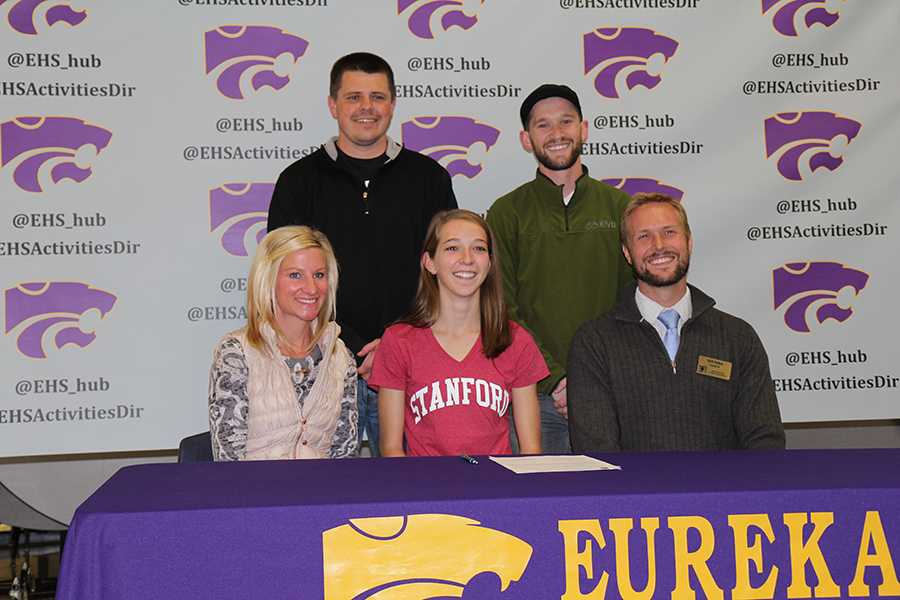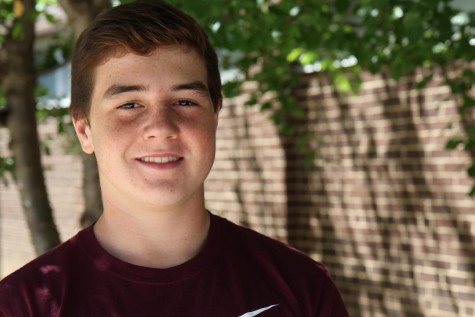The next level
Hannah Long, cross country, signs with Stanford University, Nov. 12, 2014.
February 2, 2015
The lights are radiating, the crowds roaring, the team is marching down the field, this scene is all to familiar for high school athletes and for college athletes, as well.
Only about 49 of about 800 of EHS student athletes will go on to play in college. That means most senior athletes are playing their last competitive game of their career on senior night.
“I have always wanted to be a student athlete in college,” Michael Wangerin, Quincy University, defensive end, said. “I really love the camaraderie of being on a team, and it’s a great opportunity to help pay for college.”
It takes a lot to play in college.
“I knew football plus school would be hard and time consuming, but I didn’t know it would be like a job,” Wangerin said, “It’s like you go to school then go to work.”
Playing in college requires time and effort just to get in the door, let alone balance school with athletics.
A typical day for Wangerin:
- Wake up at 6 a.m. on Tuesday and Thursday, and 7:30 on non-morning-practice days.
- Tuesdays and Thursdays he has morning practices at about 7. The remaining days of the week he goes to class.
- After class there is practice at about 3:30 p.m.
- After practice he gets something to eat.
- After practice he returns to his room to study and do homework.
- He then sleeps for about seven hours, eight when possible.
“Playing football was definitely a positive experience for Michael,” Mrs. Michelle Wangerin, mother of Michael Wangerin, said. “Just being an athlete in general has given him a lot of structure and keeps him focused on school.”
Despite the importance of athletics, academics plays an equally important role in the life of a student athlete.
“The first part of playing in college is the grades,” Mr. Farrell Shelton, head football coach, said. “You, as the athlete, have to understand what academic requirements you have to meet in order to play at certain levels of the NCAA.”
Not only do players who plan on taking their athletic careers to the next level have to focus on grades, but they of course have to have the talent to play.
“I chose a school [Stanford University] with a really great academic program,” Hannah Long, cross country, said. “I probably wouldn’t have been able to get in without my running.”
Many colleges, especially NCAA Division I universities, only give the best high school athletes an opportunity to attend school and play for them.
“An athletic scholarship is essentially money from a college in which they are giving to a student to play a sport,” Mr. Jeff Buckman, College and Career Center Specialist, said. “Students then use the money given to them to fund their college education.”
A challenge for many athletes in college is learning to adjust to the talent at the next level and adapt to their new role.
“Another thing that students quite often don’t understand is that everybody in college was either the best or one of the best players at their high school,” Coach Shelton said. “This can be hard on a student because they go from being a big fish in a small pond to a small fish in a big pond once they get to college.”
This in turn creates even more competition for those pursuing their dream of playing at the collegiate level.
“Playing sports in general and particularly in college teach people to work with others,” Mr. Glenn Erutti, father of Stephen Erutti, running back, said. “Which is something that they can use later on in life, once they get out into the real world.”
Stephen will be attending Olivet Nazarene University in the NAIA division.
The real world applications college sports are all about the people.
“Playing in high school is definitely more of a brotherhood because you’ve played with the same guys all through middle school and on into high school,” Wangerin said. “In college it’s a bunch of different guys from different states, different areas and different backgrounds, so connecting with them is a lot harder.”
It also requires athletes to do as much as possible to get themselves ahead of the competition.
“It takes a great commitment on the part of the student,” Dr. Green, activities director, said. “Within that commitment it’s not only being committed to developing your talents in a particular sport but also becoming an overall better athlete through strength and conditioning.”
Training for college-bound players never stops nor does the marketing of themselves to coaches and schools across the country.
The more an athlete markets themselves and performs to the best of their abilities the better chances they have of receiving scholarship offers from colleges.
These players marketing and promoting themselves around the country includes Ellen Schulz, volleyball hitter, who will be attending Missouri S&T next semester.
“During my junior year the team went to four qualifiers where I probably sent out between 20 and 50 emails per qualifier to all different schools, so all together I sent probably close to 300 emails,” Schulz said. “You really have to promote yourself and get yourself out there so schools can see you.”
Schulz knew she wanted to compete at a high level.
“I of course had my idea of going to a school in the south and playing Division 1,” Schulz said.
Through her process of being recruited her dream of playing division 1 volleyball changed, as a small NCAA division II school located in Rolla, Missouri (Missouri S&T) began to take interest in her.
“I had never really given S&T much thought,” Schulz said. “We were at a tournament once and the coach was there, which was odd cause I had never even emailed him or talked to him before but I ended up sending him all my information and we emailed back and fourth and soon enough I was on a visit there, touring the campus.”
Schulz, like all athletes, went to great lengths to make colleges aware of her talents.
“You have a player profile,” Schulz said. “It has your height, your approach touch and your vertical and all that stuff. It has academics, achievements and you send a video too.
Students often are unaware of what lies ahead on the road to playing at the next level as high school differs greatly from college.
Expectations for college are high for Blake Clynes, varsity pitcher, who will attend Murray State University where he will play Division I Baseball.
“I’m really looking forward to the experience,” Clynes said. “I get to travel the country playing ball and fulfill my dream.”
A dream for many but a reality for few, college sports offers a vast range of experiences.
















